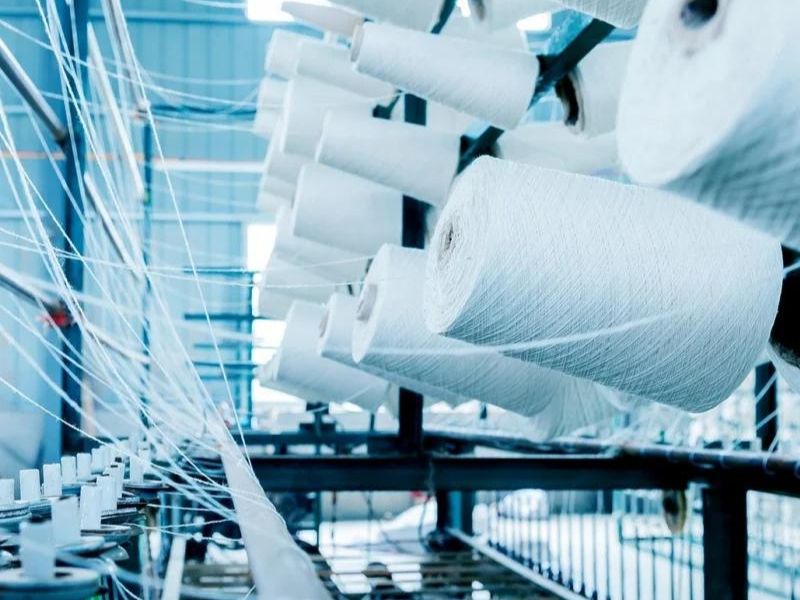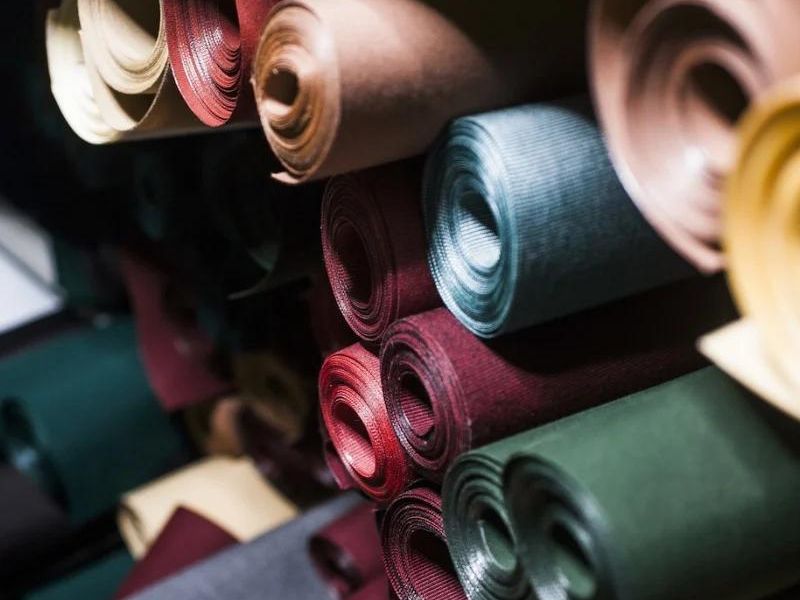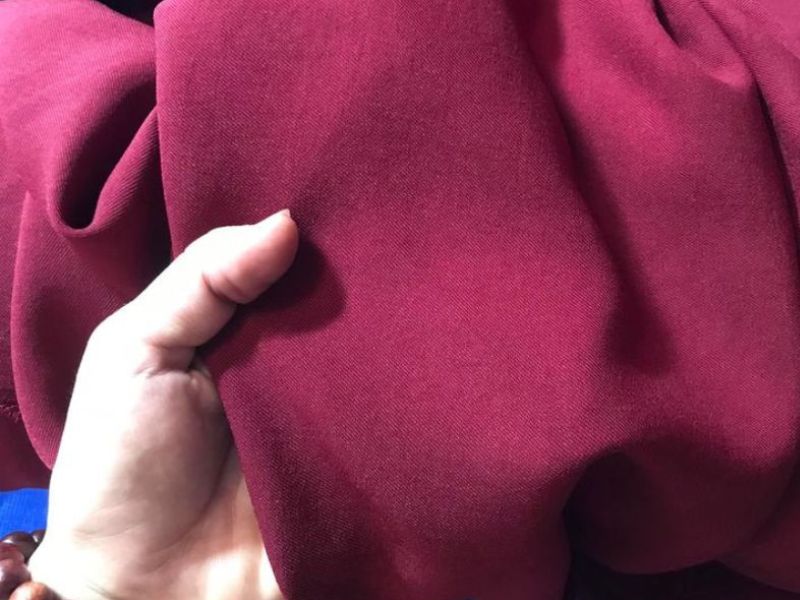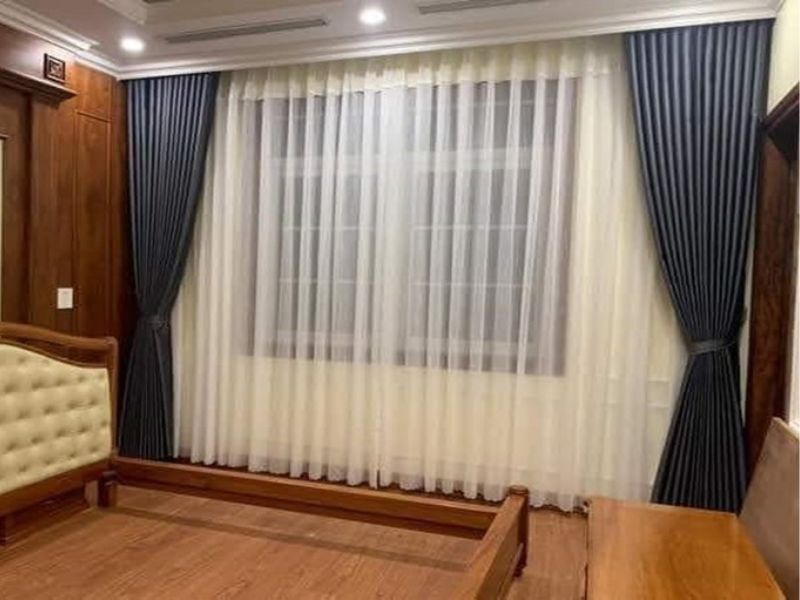Chemical fiber fabric is a popular and widely used fabric with many advantages. Learn more about it here.
What is chemical fiber fabric?
Chemical fiber fabrics are a type of fabric that is manufactured using synthetic fibers created through chemical processes. These fibers are typically composed of materials like polyester, nylon, acrylic, and rayon. As a result, chemical fiber fabrics possess several favorable qualities including durability, elasticity, and resistance to wrinkling.
Products made from chemical fibers, which are synthetic materials, offer several advantages over natural fabrics like cotton or linen. Firstly, these synthetic products are easier to care for and maintain, as they require less effort to clean and have a longer lifespan. Additionally, these products have superior color retention, meaning they will not fade or lose their vibrancy as quickly as natural fabrics.
Moreover, synthetic products made from chemical fibers tend to be more cost-effective compared to their natural counterparts. They are often produced at a lower cost, making them more affordable for consumers.
In terms of performance, products made from chemical fibers also possess excellent abrasion resistance, making them more durable and resistant to wear and tear. Furthermore, they exhibit water resistance, meaning they can repel moisture and resist stains more effectively. This feature can be particularly beneficial in environments where exposure to water or spills is frequent.
Lastly, chemical fiber products can also possess antibacterial properties, reducing the growth and spread of bacteria. This is especially advantageous in items like clothing or bedding, where maintaining hygiene and preventing odors are important considerations.
Overall, products made from chemical fibers offer a range of benefits including easy care, color retention, affordability, durability, water resistance, and antibacterial properties.

Chemical fiber fabric refers to a type of fabric that is made from synthetic or man-made fibers. These fibers are created through chemical processes, in which natural materials such as petroleum, coal, or cellulose are transformed into polymers. The polymers are then spun into fibers, which are used to produce various types of fabrics. Chemical fiber fabrics offer a wide range of characteristics and properties, depending on the specific fiber used in their production. They can be lightweight, durable, moisture-wicking, quick-drying, and resistant to wrinkles and shrinkage. Additionally, they can be engineered to have specific qualities such as flame resistance, UV protection, or antimicrobial properties. Common examples of chemical fiber fabrics include polyester, nylon, acrylic, spandex, and rayon. These fabrics are widely used in the textile industry for clothing, upholstery, household textiles, and industrial applications, providing versatility and performance in a variety of contexts.
Where are synthetic fabrics produced?
Having a deep understanding of the origins of chemical fiber fabrics is crucial in order to grasp the unique qualities and benefits associated with this particular type of fabric.
Chemical fiber fabrics are manufactured using synthetic raw materials that are derived mainly from petroleum and natural gas. These raw materials are processed to produce chemical fibers such as polyester, nylon, acrylic, and Rayon. These fibers are created from chemical compounds that are derived from the aforementioned raw materials.
- Oil: Petroleum is the main source of raw materials for the production of chemical fibers such as polyester and nylon. From petroleum, compounds such as ethylene and propylene are extracted and then used to produce synthetic fibers.
- Gas: Natural gas, mainly methane, is also an important raw material for the production of synthetic fibers such as acrylic. From the gas, compounds such as acrylonitrile are produced and then converted into acrylic fibers.
- Cellulose from plants: Rayon, although not 100% synthetic, is often considered a chemical fiber fabric. Cellulose from plants such as wood and other trees is processed to create rayon fibers through chemical processes.
Chemical fiber fabrics are primarily made from synthetic raw materials, including petroleum, gas, and plant cellulose. The manufacturing process of chemical fibers involves intricate chemical and technological procedures aimed at producing fabrics with diverse properties and applications.

Where are chemical fiber fabrics manufactured?
What is the number of different chemical fiber fabrics available?
There are three main types of chemical fiber fabrics based on their main raw materials and production process. These types are divided as follows:
- Synthetic fabric: This is a chemical fiber fabric that is made from completely synthetic materials such as petroleum or gas. Common synthetic fibers include polyester, nylon, and acrylic. These fabrics are usually durable, resilient, and easy to maintain.
- Recycled natural or synthetic fibers: Some synthetic fabrics are made from recycled natural materials such as cellulose from wood, bamboo, or plants. Common examples include rayon, lyocell, and modal. These fabrics can feel softer and more breathable than synthetic fibers.
- Mixed yarn: Sometimes, manufacturers combine both synthetic and natural fibers to create blended fabrics. These blends can provide the best structural properties and characteristics of both sources. However, these blends are more complex to manufacture and are often much more expensive.
Each type of chemical fiber fabric possesses unique characteristics and applications, which are influenced by factors such as the raw materials used and the manufacturing process employed.

There are numerous types of chemical fiber fabrics available in the market. These fabrics are manufactured using synthetic materials such as polyester, nylon, acrylic, and spandex. Each type of chemical fiber fabric has its own unique characteristics and properties, making them suitable for various applications. Some commonly known types of chemical fiber fabrics include polyester fabrics, nylon fabrics, acrylic fabrics, and spandex fabrics. However, there are many more types available, all offering different textures, strengths, and levels of stretchability. The wide range of chemical fiber fabrics ensures that there is a fabric suitable for every need and preference.
What are the traits of synthetic fabrics made from chemical fibers?
Benefits of synthetic fiber fabrics include durability, wrinkle resistance, moisture wicking, and low cost.
Chemical fiber fabrics possess numerous advantages that make them highly sought after in the fashion and fabric manufacturing industry. These advantages include: durability, versatility, affordability, low maintenance, and a wide range of options.
Firstly, chemical fiber fabrics are known for their exceptional durability. They have a high resistance to wear and tear, making them long-lasting and able to withstand daily use. This durability ensures that garments and textiles made from chemical fiber fabrics maintain their quality and appearance over time.
Secondly, chemical fiber fabrics are extremely versatile. They can be easily blended with other materials such as cotton or wool to enhance their properties. This versatility allows for the creation of fabrics with diverse textures, weights, and functionalities, expanding the possibilities for designers and manufacturers.
Affordability is another significant advantage of chemical fiber fabrics. As compared to natural fibers like silk or cashmere, chemical fiber fabrics are more affordable to produce. This affordability translates to more accessible and reasonably priced fashion and textile options for consumers.
In terms of maintenance, chemical fiber fabrics are relatively low maintenance. They are generally resistant to wrinkling, enabling them to maintain their smooth and neat appearance with minimal effort. Additionally, these fabrics often have a quick-drying property, reducing the need for lengthy drying times after washing.
Lastly, chemical fiber fabrics offer a wide range of options to choose from. They can be produced in various colors, patterns, and sheens, allowing designers to create visually stunning and unique garments. Moreover, advancements in technology have enabled the manufacturing of chemical fiber fabrics that mimic the luxurious feel and appearance of natural fibers.
All in all, the versatility, durability, affordability, low maintenance, and wide range of options make chemical fiber fabrics highly desirable in the fashion and fabric manufacturing industry. Their advantages continue to contribute to their popularity and widespread use in various garments and textile products.
- Durable: Synthetic fabrics are generally more durable than natural fabrics such as cotton and linen. This makes them less susceptible to tearing or wear during use and washing.
- Good elasticity and stretch: Chemical fiber fabrics such as polyester and spandex have good stretch and elasticity, helping the wearer always feel comfortable and the clothes do not shrink during use.
- Good anti-wrinkle ability: Chemical fiber fabrics are often less wrinkled and easier to flatten after washing, helping clothes to always keep their original shape and design.
- Easy to maintain and care for: Chemical fiber fabrics generally do not require special maintenance and are easy to care for. They can usually be machine washed and dried without problems such as shrinkage, discoloration or wrinkling.
- Good color retention: Chemical fiber fabrics usually hold their color better over time and do not fade as easily during washing or exposure to sunlight.
- Variety of designs and textures: Chemical fiber fabrics can be produced in a variety of designs and textures, from thick to thin fabrics, from soft to sturdy fibers, fully meeting the needs of many applications in life and different fashion styles.
- Good price: Another outstanding advantage of chemical fiber fabric is that it has an extremely affordable price. This has helped this type of fabric become popular and favored in the fashion industry as well as widely used in life.

There are several advantages of using chemical fiber fabrics. These fabrics offer various benefits that make them desirable for a wide range of applications.
Chemical fiber fabrics are lightweight and flexible, making them easy to handle and wear. They are known for their durability and resistance to wear and tear, which makes them long-lasting. These fabrics also have a high tensile strength, which allows them to withstand significant stress without breaking or tearing.
One of the main advantages of chemical fiber fabrics is their ability to be easily dyed and printed with vibrant colors and intricate patterns. This makes them popular in the fashion industry, as they can be used to create visually appealing garments and accessories. Moreover, chemical fiber fabrics have excellent color retention, ensuring that the colors remain vibrant even after repeated washings.
In addition to their aesthetic appeal, chemical fiber fabrics offer a range of functional benefits. They have excellent moisture-wicking properties, which means they can absorb and release moisture quickly. This makes them suitable for activewear and sports clothing, as they help keep the wearer dry and comfortable during physical activities.
Chemical fiber fabrics also have good resistance to chemicals and UV radiation. This makes them suitable for outdoor applications, such as outdoor furniture or awnings, as they can withstand exposure to sunlight and other harsh elements without deteriorating.
Furthermore, chemical fiber fabrics are often more cost-effective compared to natural fibers. They can be produced at a lower cost and in larger quantities, making them a more affordable option for various industries.
Overall, the advantages of chemical fiber fabrics include their lightweight and flexible nature, durability, vibrant colors, moisture-wicking properties, resistance to chemicals and UV radiation, and cost-effectiveness. These benefits make them a popular choice for a wide range of applications, from apparel to home furnishings.
Drawbacks of synthetic fabrics include limited breathability, potential for allergies, and environmental concerns due to non-biodegradable nature.
While chemical fiber fabrics possess numerous advantages, it is important to acknowledge their potential drawbacks as well.
- Poor sweat absorption: Some chemical fiber fabrics such as polyester have poorer sweat absorption than natural fabrics such as cotton, which can increase the feeling of heat and stuffiness when worn in hot weather.
- May cause skin irritation: Some people may react to the chemicals in synthetic fabrics, causing problems such as skin irritation, itching, and allergies.
- High flammability: Some chemical fiber fabrics such as polyester have the ability to burn more rapidly and not self-extinguish when exposed to fire, which can increase the risk of fire and injury when exposed to flames.
- Polluting the environment: The production process of chemical fiber fabrics often uses a lot of chemicals and energy, causing environmental pollution and consuming natural resources.
Nevertheless, the drawbacks mentioned above can be mitigated by leveraging advanced manufacturing technology and implementing suitable product care protocols.

Chemical fiber fabrics have several disadvantages that should be considered. These fabrics are made from synthetic fibers, such as polyester or nylon, which are manufactured using chemical processes. One major drawback is that chemical fiber fabrics tend to have a lower breathability compared to natural fabrics like cotton or linen. This means that they can trap heat and moisture against the skin, leading to discomfort and potential skin irritation. Additionally, chemical fiber fabrics can be less durable than natural fibers, often prone to pilling or losing shape over time. They may also have a tendency to generate static electricity, causing garments to cling to the body or attract lint and dust. Finally, chemical fiber fabrics are not biodegradable and can contribute to environmental pollution when disposed of improperly.
Chemical fiber fabrics are commonly used in various applications such as clothing, automotive upholstery, and home furnishings.
Chemical fiber fabrics are highly versatile and find extensive use across various industries. They have a wide range of common applications in numerous fields, such as:
- Fashion: Chemical fiber fabrics are widely used in the fashion industry, clothing production such as shirt, T-shirt, jacket… Clothing made from chemical fiber fabrics is often durable, has beautiful colors and is easy to maintain, suitable for many styles and purposes.
- Household appliances: Chemical fiber fabrics are also used to make bed sheets, curtains, tablecloths and other household products. They can have water-resistant, wrinkle-resistant and easy-to-clean properties, making them easier to maintain and use.
- Health: Some chemical fiber fabrics such as polyester and nylon are used in the production of medical protective gear such as masks, surgical gowns, and medical lining materials. They can be treated to be antibacterial and water-repellent.
- Automotive industry: Chemical fiber fabrics are also used in many industrial applications such as filtration, lining, packaging and insulation. They can have abrasion, heat and chemical resistance properties, suitable for the demanding requirements of automotive industry manufacturing.

Chemical fiber fabrics are widely used in various applications due to their unique properties. These fabrics are synthetic fibers made from materials such as polyester, nylon, and acrylic. Their versatile nature makes them suitable for a range of purposes.
One common application of chemical fiber fabrics is in the textile industry. They are used to manufacture clothing, including shirts, dresses, and pants. These fabrics are popular because they are lightweight, durable, and easy to care for. They also offer a wide array of designs, colors, and textures, allowing for endless possibilities in fashion.
Additionally, chemical fiber fabrics are widely utilized in the production of home furnishings. They are used to make curtains, upholstery, and bedding. The fabrics’ resilience and resistance to wrinkles make them ideal for these applications. They can withstand regular use and are easy to clean, making them a practical choice for households.
In the automotive industry, chemical fiber fabrics find their place in the manufacturing of car seats and interiors. These fabrics provide comfort, durability, and resistance to wear and tear. Moreover, they can be treated to be fire-resistant and stain-resistant, enhancing safety and cleanliness.
Furthermore, chemical fiber fabrics have multiple uses in the medical field. They are used to manufacture surgical gowns, masks, and other protective equipment. These fabrics are often treated with antimicrobial agents to inhibit the growth of bacteria. Their ability to be sterilized and their resistance to chemicals make them a reliable choice in healthcare settings.
Lastly, chemical fiber fabrics are utilized in the production of sports and outdoor equipment. They are used to make athletic wear, backpacks, tents, and even ropes for rock climbing. These fabrics offer features such as moisture-wicking, breathability, and weather resistance, contributing to performance and endurance in outdoor activities.
Overall, chemical fiber fabrics have numerous applications due to their exceptional properties. They are lightweight, durable, and easy to care for, making them suitable for various industries including textiles, home furnishings, automotive, medical, and sports.
summary
By reading this article, you will be able to acquire valuable information about chemical fiber fabrics. It is encouraged to stay updated with Fashion Bandung’s latest news in order to stay current with global fashion trends and expand your knowledge of the fashion industry.
Fashion Bandung is a fashion brand that specializes in clothing for men. With a focus on style and trends, Fashion Bandung offers a wide range of apparel designed to cater to the fashion-forward male consumer. From casual wear to formal attire, Fashion Bandung ensures that men can find the perfect ensemble for any occasion. With their attention to detail and use of high-quality materials, Fashion Bandung provides men with fashionable options that combine comfort and style. Whether it’s for everyday wear or a special event, Fashion Bandung aims to provide men with clothing that allows them to express their individuality and personal style.
For further information or to explore more details, please refer to the following:

Author: Ngo Thi Hong Nga
Role: Editor
Ngo Thi Hong Nga is a skilled and experienced editor. With a passion for language and an eye for detail, Nga excels in refining and polishing written content. Nga is dedicated to ensuring that every piece of writing meets the highest standards of clarity, coherence, and accuracy.
As an editor, Nga meticulously reviews documents, identifying and correcting any grammatical errors, spelling mistakes, and punctuation errors. Nga also pays close attention to sentence structure and syntax, making necessary adjustments to improve the overall flow and readability of the text.
Furthermore, Nga understands the importance of maintaining the author’s voice and style while enhancing the quality of the writing. Nga works closely with authors, offering suggestions and feedback to help them craft their ideas effectively and compellingly.
Nga’s expertise is not limited to one particular field but spans across various genres and topics. Whether it be academic papers, business proposals, creative writing, or online content, Nga has the knowledge and skills to enhance any type of written material.
With a sharp eye for detail and a passion for communication, Ngo Thi Hong Nga is an indispensable asset to any writing project. Nga’s commitment to excellence and dedication to maintaining the integrity of the author’s work make Nga an exceptional editor.

